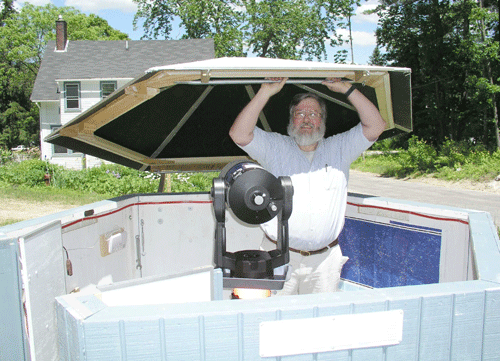
 |
|
|
mmmmmmm |
|
|
|
|
A
Hexagonal Observatory
By Marc Stowbridge
I live in rural central New Hampshire, with clear, dark skies
and long winters. I didn't want to leave my equipment out unattended
on snowy nights as my tripod would sag into the ice by the time
it, and I, reached thermal equilibrium. I wanted an enclosure
where I could comfortably use my LX-90 Schmidt-Cassegrain telescope,
even when there was three feet of snow on the ground. I decided
to design and build an observatory that was easy to make, inexpensive,
and adaptable. The resulting structure is about 7 ½ feet
in diameter and has walls about 4 feet high. It is designed to
be somewhat portable, in that I can prefabricate the sections
at home and assemble it somewhere else.
|
|
| |
| |
| |
| |
| |
| |
| |
| |
| |
|
|
|
| |
|
|
|
| |
|
|
|
Building
Details
The observatory walls are made of six 4-by-4-foot sections consisting
of siding glued and nailed to frames made of 2-by-4s. Each wall
section is mitered and bolted to the adjoining segment. The observatory
sits upon a hexagonal foundation made of four layers of interlocking
pressure treated 2-by-4s, anchoring the building and providing solid
support. The floor has been covered with sand for leveling and drainage,
and covered by interlocking rubber mats cut to fit. To help the
observatory cool off after hot days, I installed louvered vents
in 5 of the walls and a thermostatically controlled wall fan.
The roof is made of 6 trapezoids of {3/8}-inch plywood, and a small
hexagonal cap at the top, all finished with marine grade paint.
Aluminum struts provide a flange for bolting the plywood pieces
together. The roof has an interior support frame made of angled
and mitered 2-by-4s with plywood gussets to provide rigidity. When
the roof is closed, this frame rests upon the top of the observatory
wall.
To
support the open roof, rails of pressure treated 2-by-4s extend
from the North wall. The roof rides on these rails with simple rollers
made of 6 -inch lengths of {3/4}-inch-diameter conduit that turn
on a {1/2}-inch conduit axle. The rollers ride right over ice and
snow. Safety cables attached to the roof loop around the rails,
preventing the roof from blowing off in a gust of wind. A counterweight
extends from the roof, making it easy to lift. |
|
|
| |
| |
| |
| |
| |
| |
| |
|
|
|
 |
Inside
the Observatory
My telescope sits atop a 39-inch-high pier made from a length
of aluminum highway light pole, bolted to a 150-pound bucket of
concrete. The pier is closed with a disk of plywood at the bottom
and is filled with sand to dampen vibration. The same bolt and
hand-wheel found on an LX90 tripod secures the scope to a wooden
plug fitted to the top of the pier. A 9X14? cake pan between the
scope and pier serves as a very convenient accessory tray.
Preparing
for a night of observing takes only a few minutes. In winter,
preliminaries consist of shoveling a path to the door and sweeping
the snow off the roof. After unlocking the doors, I remove the
turnbuckles that hold the roof closed. Then, by lifting a handle
on the roof?s interior, I walk the 20-pound roof up and over the
telescope, and onto the support frame. And just like that, I?m
all set to power up my scope and enjoy the night sky. I like showing
my friends the surprising things above us. By keeping the setup
time to a minimum and making the surroundings comfortable, we're
able to focus, as it were, on the sky.
|
|
| |
|
|
| |
|
|
|
| |
|
|
|
| |
|
|
|
| |
|
|
|
| |
|
|
|
| |
|
|
|
|
